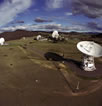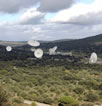|
Not since
the days of Apollo have NASA navigators performed course
plotting designed to bring a spacecraft from beyond
Earth's orbit to a predestined landing zone on Earth.
To do so, the Genesis navigation team calls upon the
giant dishes of NASA's Deep Space Network to provide
data on the Genesis trajectory. Navigators analyze the
spacecraft's radio signal using techniques called radiometric
and Doppler tracking to help pinpoint its distance from
Earth as an aid to navigation.
Throughout the Genesis mission, tracking and telecommunications
have been provided by NASA's Deep Space Network complexes
in California, Australia and Spain. The data rate from
the spacecraft ranges from 1 to 47 kilobits per second.
The Deep Space Network receives most data from
the spacecraft through 34-meter-diameter (110-foot) antennas,
but 26-meter (85-foot) antennas have also occasionally
been used.
 |
 |
 |
 |
 |
| 70-meter (230 ft) at Goldstone Complex, California |
|
Canberra Complex, Australia, Showing the 70-meter (230 ft.) Antenna and the 34-meter (110 ft.) Antennas |
|
View of the entire Madrid Antenna Complex, Madrid, Spain |
|
